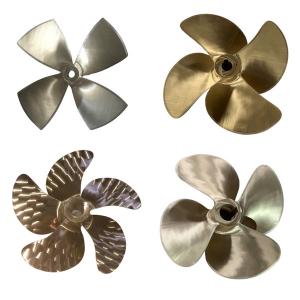Copper Alloy Shaft Marine Propeller Controllable Fixed Pitch Propellers
Add to Cart
Marine Propeller Controllable Fixed Pitch Propellers Shaft Copper Alloy Ship Propeller
Type of blade | 2,3,4,5 |
Material of propeller | Alloy, Cooper, Bronze |
The working principle of Marine propeller
The working principle of the Marine propeller can be explained from
two different points of view, one is the change of momentum, the
other is the change of pressure. In the view of momentum change,
simply speaking, the propeller accelerates through the water,
causing the water momentum to increase and the counterforce to push
the ship. Since momentum is the product of mass and velocity,
different masses combined with different velocity changes can cause
different degrees of momentum changes.
On the other hand, the principle of propeller action can be more
clearly explained from the point of view of pressure variation. A
propeller is made up of a group of wings, so its action is similar
to that of a wing. The wing depends on the geometric change of the
wing surface and the attack Angle of the incoming flow, so that the
fluid flowing under the wing surface has a different velocity, and
according to Bernoulli's law, different velocity will cause
different pressure on the lower surface of the wing surface, thus
generating lift force. The movement of the wing surface of the
propeller blade is synthesized by the advance and rotation of the
propeller. Without considering the influence of friction between
fluid and surface, the lift force of the wing in the forward
direction is the thrust of the propeller, while the lift force in
the rotation direction is the torque force that the main engine of
the ship must overcome.
Chinese characteristics - close the blade and paddle
The most arrogant is the advent of the "blade blade", which is a
great creation in the development of propeller technology in China.
In the 1960s, there was a master named Zhou Ting in Wenchong
Shipyard in Guangzhou. According to his decades of experience in
propeller making, he made the blade outline of the propeller into
the shape of Guan Gong's 82-jin heavy Dao in the Romance of the
Three Kingdoms, which he called "Guan Dao Oar".
The Closing Oar has been tested on a number of ships, increasing
the speed of the ship, and what is more, greatly reducing the
vibration of the spiral. In the Yangtze River 2000 horsepower tug
and Chinese landing craft use, have achieved good results, this
achievement, attracted many shipbuilding industries. In 1973, the
first open water test of "closing blade blade" was conducted in
Shanghai, and the design chart was also provided.
Close the blade, the important feature is vibration, low noise.
The classification of modern propellers
According to the structure of the blade, the propeller is divided into a fixed pitch propeller (fixed pitch propeller) and an adjustable pitch propeller (adjustable pitch propeller).
Adjustable from pulp
On the basis of ordinary propellers, in order to improve performance, better adapt to various sailing conditions and make full use of the power of the main engine, the following special propellers have been developed.
Ducted propeller
Contra-rotating propeller
There is also a series of propellers and so on



